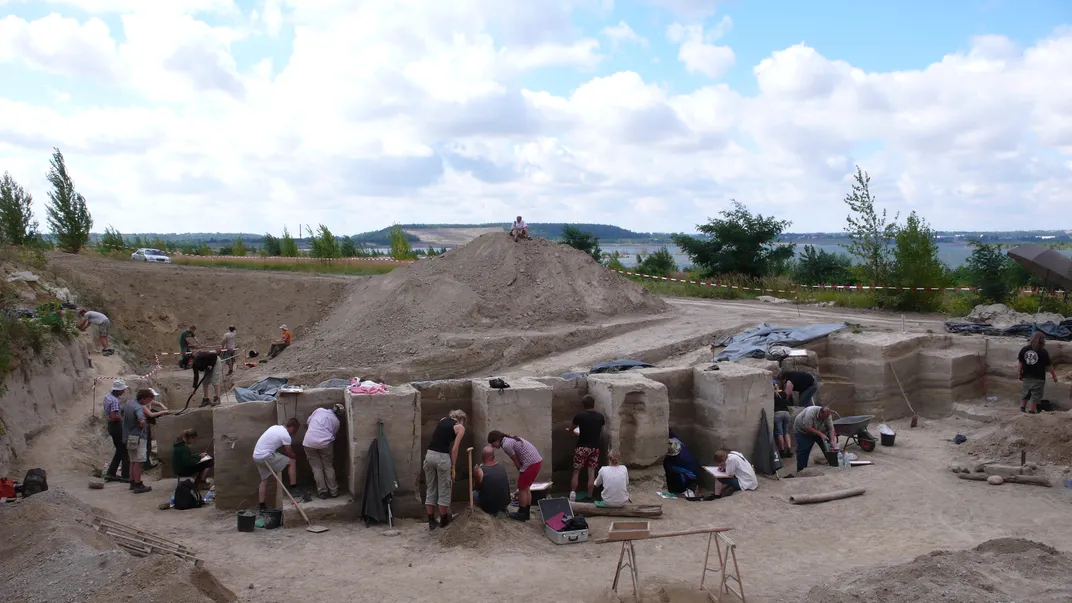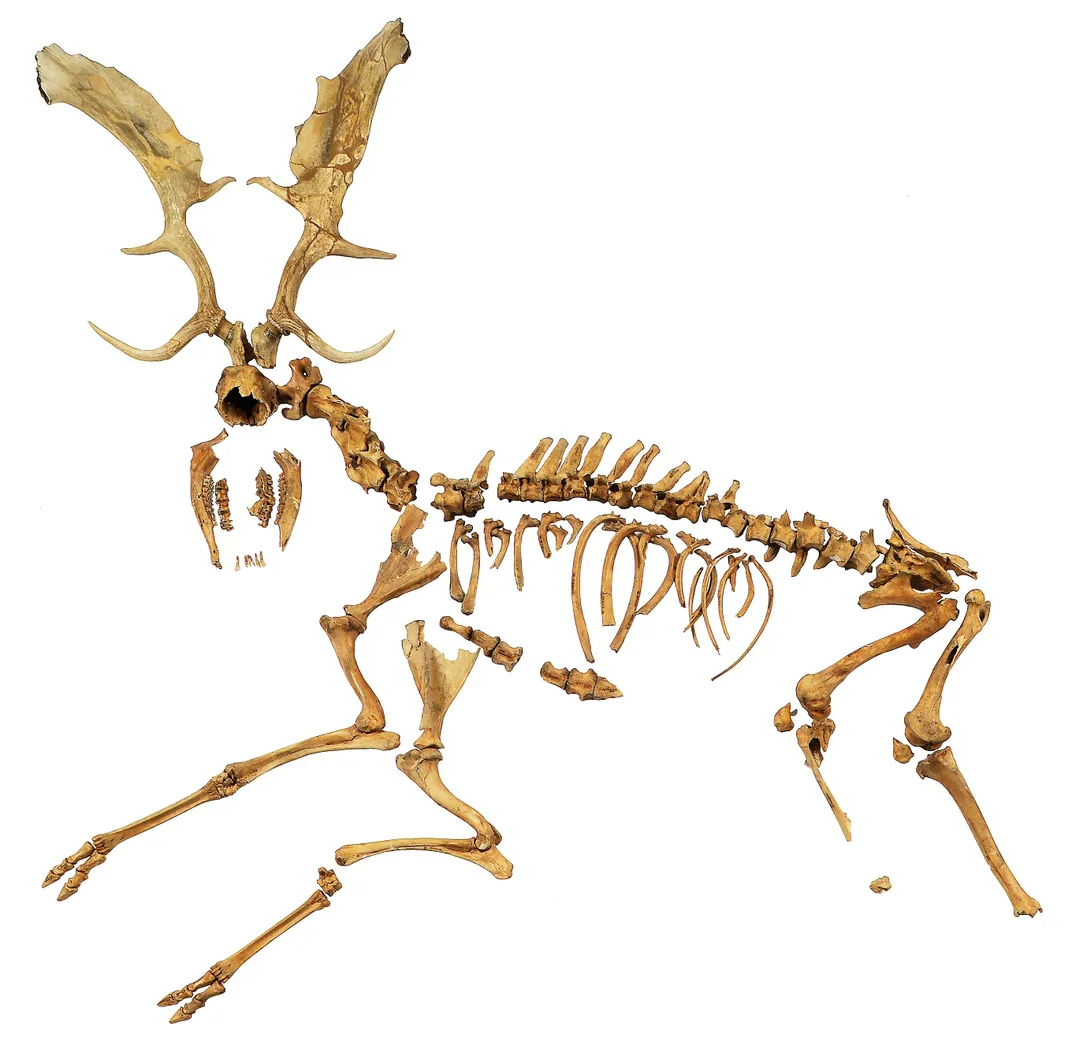Neanderthals Hunted in Groups, One More Strike Against the Dumb Brute Myth
The skeletons of deer killed 120,000 years ago offer more evidence of cooperative behavior and risk-taking among our hominin relatives
/https://tf-cmsv2-smithsonianmag-media.s3.amazonaws.com/filer/64/5e/645e2dd9-82be-4018-be85-f196b8800513/mammoth-2.jpg)
On an autumn day around 120,000 years ago, in the dense forests of what would come to be Germany, fierce hunters prowled the landscape.
These hunters regularly brought down mammoths and woolly rhinoceroses, deer, wild horses, aurochs (extinct bulls) and straight-tusked elephants. They competed for these prizes against other predators like hyenas and lions, sometimes losing their lives in the process. But today their skills and tools proved their worth: A group of Neanderthals used their hand-crafted wooden spears to kill two male fallow deer, both in the prime of their life and heavy with valuable meat and fat.
We know this because those skeletons, with bones bearing the signs the people who killed them, were recovered in 1988 and 1997 in a site called Neumark-Nord. This week, researchers argue in a new paper in Nature Ecology & Evolution that those punctured bones are the oldest example of hunting marks in the history of homininkind. That would mean that Neanderthals used sophisticated close-range hunting techniques to capture their prey—adding more weight to the argument that they were much smarter than we once gave them credit for.
“This has a lot of implications, as groups of hunters had to closely cooperate, to rely on each other,” said Johannes Gutenberg University archaeologist Sabine Gaudzinski-Windheuser, one of the study’s authors, by email. “Our findings must be understood as one of the best evidence known so far that provides insight into the social set up of Neanderthals.”
This new research is only the latest in a recent string of studies that indicate Neanderthals were our genetic and perhaps cultural cousins: complex, emphathetic hominins. Neanderthals have now been credited with creating symbolic art, producing geometric structures of broken stalagmites in underground caves and controlling fire to use on tools and food. Moreover, they successfully exploited whatever environment they happened to live in, be it the snowy tundra of Ice Age Europe, or heavily forested lakeshores during the interglacial periods.
This is a sea-change from how anthropologists once viewed this group of hominins: as a species doomed to extinction. Such a view meant that researchers were always looking for what weaknesses had set Neanderthals up for failure, rather than the skills that allowed them to successfully survive for so long.

“Maybe 10 years ago the story [of this study] would’ve been, Neanderthals couldn’t throw, because they had a different shoulder structure, and there’s an implication of cognitive limitation—that they weren’t using thrown projectiles,” says Penny Spikins, a senior lecturer in archaeology at the University of York who wasn’t affiliated with the study. “Now we see it in terms of the continuity of human adaptation. They’re choosing from various hunting options open to them, and this choice demonstrates a lot of collaboration.”
Spikins is particularly interested in hunting strategies, because her research focus is Neanderthal “healthcare.” No, Neanderthals weren’t opening up medical practices or offering insurance (that we know of)—but they did help one another recover from injuries that might’ve been sustained in dangerous activities like close-range hunting, as seen in bones that show recovery from wounds. To Spikins, that suggests tight-knit social networks and empathetic support of one another, which she and her colleagues wrote about in a February paper for World Archaeology.
To understand the precise mechanics of how this close-range hunting would have worked, Gaudzinski-Windheuser and her colleagues decided to recreate the scene. First, they set up the targets: 24 skeletons from German red deer (the species of fallow deer the Neanderthals hunted are now extinct, and this was the closest modern analogy) embedded in ballistics gel to simulate flesh. Then the group recruited three men versed in weaponry to recreate the attack.
The spears were made from metal poles with a wooden point at the end, as evidence from other archaeological sites shows the Neanderthals of the period were using wooden spears for their hunts. Sensors were attached to the spears to measure their motion and the velocity of the impact against the bones as the mock hunters thrust their weapons into the “deer.” The end result: damage patterns on the pelvis and scapulae bones that exactly mimicked the puncture marks on the ancient deer.
For the authors, that meant the spears were probably thrust rather than thrown—but in a different context, they note, throwing was still possible. “I like the fact that the authors are taking a more nuanced approach by acknowledging that spears can do both, thrusting and throwing,” says paleoanthropologist Rebecca Wragg Sykes, an archaeological researcher affiliated with the Université de Bordeaux who didn’t participate in the study.
Wragg Sykes agrees with Spikins that the interpretation of this study reflects a transformation in how researchers view Neanderthals. “People traditionally have looked for differences between the two species [Neanderthals and Homo sapiens], and if you’re looking for reasons why Neanderthals disappear from the fossil record, then you would want to look at whether their lives were riskier,” she says. Today, Neanderthals are considered “a parallel course of what it could mean to be a kind of human.”

For Spikins, the origins of this paradigm shift date back to 2010, when researchers discovered that Neanderthal DNA lives on in modern humans of European and Asian descent. In other words, the two species interbred. Suddenly Neanderthals weren’t just an evolutionary dead end; they were more similar to and indeed a part of us. More research pointed to the possibility of other species of hominin populating the globe at the same time, from Homo heidelbergensis of Eurasia to Homo naledi of South Africa.
“Our own ancestor were just one of many different options of humans at the time,” Spikins says, “and that’s given us a perspective in which we can see there were different types of humans adapting in different ways.”
Both Spikins and Wragg Sykes have questions that remain unanswered. Wragg Sykes noted that the deer remains present an enigma: Normally, the hunters would’ve left far more cut marks on the bones, and would’ve removed parts of the body like the brain, the fat, and the tongue, which were the most nutrient-dense. These bones remain fully assembled, and only one deer shows faint traces of butchery. “They don’t tend to leave entire carcasses,” Wragg Sykes says.
Maybe the hunters were scared off from their prey by the arrival of other dangerous predators; or maybe they were so successful in their hunting that they didn’t require anything more than some meat and the skins of the animals.
Spikins wants to continue exploring the intersection between hunting and healthcare among Neanderthals, and this finding offers an intriguing avenue to do so. “Some of [the hunters] were volunteering to be in positions where they were more likely to be injured,” Spikins says of hunting at close-range. Taking that risk meant there was a high reward, and likely some kind of safety net that would allow them to do so. “I’m interested in how the emotional element of Neanderthal lives was intimately connected to the economics of their existence.”
As for Gaudzinski-Windheuser and her colleagues, they’re eager to bring their success with this experiment to the field at large. “Numerous researchers are currently dealing with studies on weaponry in Pleistocene contexts,” Gaudzinski-Windheuser said. She and a colleague have organized their work in ‘ballistic archaeology’ so that more archaeological work might be brought “under the umbrella of physics,” she says.
For now, paleoanthropologists will continue digging into Neanderthal history, focusing both on what makes them different from Homo sapiens, and what similarities they share. And anytime we start feeling complacent about the fact that our species survived and others didn’t, Spikins has her own remedy for that mindset: “They were successful for longer than we yet have been.” Neanderthals thrived for some 250,000 years in some of the harshest and most variable climates on Earth. As for whether Homo sapiens will have such a long run—that remains to be seen.
/https://tf-cmsv2-smithsonianmag-media.s3.amazonaws.com/accounts/headshot/lorraine.png)
/https://tf-cmsv2-smithsonianmag-media.s3.amazonaws.com/accounts/headshot/lorraine.png)